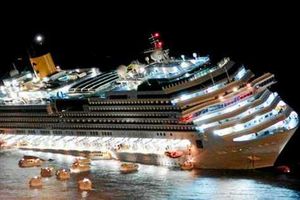The Sinking of the Concordia - TV review
It is a week for remembering maritime disasters, writes Sally Walmsley. Tuesday marked the day doomed ship the Titanic set sail from the docks of Southampton a century ago, so it was apt that Channel Four chose this week to screen their astonishing documentary on the fate of the Costa Concordia.

It is a week for remembering maritime disasters,
. Tuesday marked the day doomed ship the Titanic set sail from the docks of Southampton a century ago, so it was apt that Channel Four chose this week to screen their astonishing documentary on the fate of the Costa Concordia, which ran aground off Italy, just three short months ago, on Janury 13.
A total of 32 people of the 4,252 aboard the Costa Concordia lost their lives. And in last night's documentary - The Sinking of the Concordia: Caught on Camera - Channel 4 pieced together footage taken by passengers on board to give a terrifying overview of what happened during its last hours.
As the narrator reminded us at the at the start of the hour-long documentary: "There is no director, no camera crew, no reconstructions.
"Just home videos and the voices of the survivors . . . What follows is the anatomy of a disaster."
The programme started with shots of happy children running on deck, holiday-makers enjoying fitness classes, stage shows, a gala night and bingo – at which point the grim inevitability of what was about to happen hit you smack in the face.
And as you look around the smiling faces in the crowd shots you are already starting to think 'Did they get out alive?'
As it became evident something was seriously wrong, the feeling of terror building among the passengers was evident, to the point where the fear was palpable.
Footage from the bridge showed all hell breaking loose - and revealed that passengers had already decided to make their way to the lifeboats before the captain made the call to abandon ship.
To say Captain Francesco Schettino did now come out of this documentray well is the understatement of the century.
Eyewitness accounts taken down after the event are one thing – the evidence included in this programme about the behaviour of the captain just staggering.
We heard the cheery announcement over the PA system that there had been a' blackout' . . . 'electrical fault' . . . 'engineers working to resolve the problem', despite the fact the ship had run aground.
Some of the scenes with the strongest impact showed footage from the search and rescue helicopter – and included the furious exchange between Captain Schettino and the coastguard, who ordered the captain back onto the ship, after he and his officers abandoned the passengers to their fate, warning him: "I am going to make you pay for this."
The decision to screen the vast majority of the footage without any voiceovers was a brave, but inspired move This was never more effective as during the scenes which showed one of the lifeboats which had got stuck, filled with passengers and hanging from the side of the ship. This, more than anything brought it home to the viewer quite how on their own these people were.
Like them, you had no idea what was happening, or how it was going to end.
You – like them – were in the pitch black of the lifeboat. You could hear people screaming all around – people who thought they were going to die.
It was like something from a horror movie.
The sight of a body being brought off one of the boats, the flickering lights shone by people still trapped in the sinking ship desperately trying to attract help.
They were all poignant moments. As one of the passengers said from the shore: "It's like a scene from Titanic".
This programme brought home the reality of the disaster for the people on board, more than any sterile TV report could do.
The people who took this footage – even when their own lives and those of their loved ones were in danger – should be commended. As should those who spent the many, many hours it must have taken to edit this footage together.
This was a sensitive and painstakingly put together record of a terrible human tragedy.





